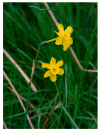The Anti-Cholinesterase Potential of Fifteen Different Species of Narcissus L. (Amaryllidaceae) Collected in Spain
- PMID: 38672806
- PMCID: PMC11050805
- DOI: 10.3390/life14040536
The Anti-Cholinesterase Potential of Fifteen Different Species of Narcissus L. (Amaryllidaceae) Collected in Spain
Abstract
Narcissus L. is a renowned plant genus with a notable center of diversity and is primarily located in the Mediterranean region. These plants are widely recognized for their ornamental value, owing to the beauty of their flowers; nonetheless, they also hold pharmacological importance. In Europe, pharmaceutical companies usually use the bulbs of Narcissus pseudonarcissus cv. Carlton to extract galanthamine, which is one of the few medications approved by the FDA for the palliative treatment of mild-to-moderate symptoms of Alzheimer's disease. The purpose of this study was to evaluate the potential of these plants in Alzheimer's disease. The alkaloid extract from the leaves of different species of Narcissus was obtained by an acid-base extraction work-up -procedure. The biological potential of the samples was carried out by evaluating their ability to inhibit the enzymes acetyl- and butyrylcholinesterase (AChE and BuChE, respectively). The species N. jacetanus exhibited the best inhibition values against AChE, with IC50 values of 0.75 ± 0.03 µg·mL-1, while N. jonquilla was the most active against BuChE, with IC50 values of 11.72 ± 1.15 µg·mL-1.
Keywords: Alzheimer’s disease; Amaryllidaceae; Narcissus; acetylcholinesterase; alkaloids; butyrylcholinesterase.
Conflict of interest statement
The authors declare no conflicts of interest.
Figures





References
-
- Bremer B., Bremer K., Chase M.W., Fay M.F., Reveal J.L., Bailey L.H., Soltis D.E., Soltis P.S., Stevens P.F., Anderberg A.A., et al. An update of the Angiosperm Phylogeny Group classification for the orders and families of flowering plants: APG III. Bot. J. Linn. Soc. 2009;161:105–121. doi: 10.1111/j.1095-8339.2009.00996.x. - DOI
-
- Hanks G.R., editor. Narcissus and Daffodil: The Genus Narcissus. Taylor & Francis; London, UK: 2002. pp. 1–428. (vol. 21 in the series: ‘‘Medicinal and Aromatic Plants—Industrial Profiles).
Grants and funding
LinkOut - more resources
Full Text Sources

